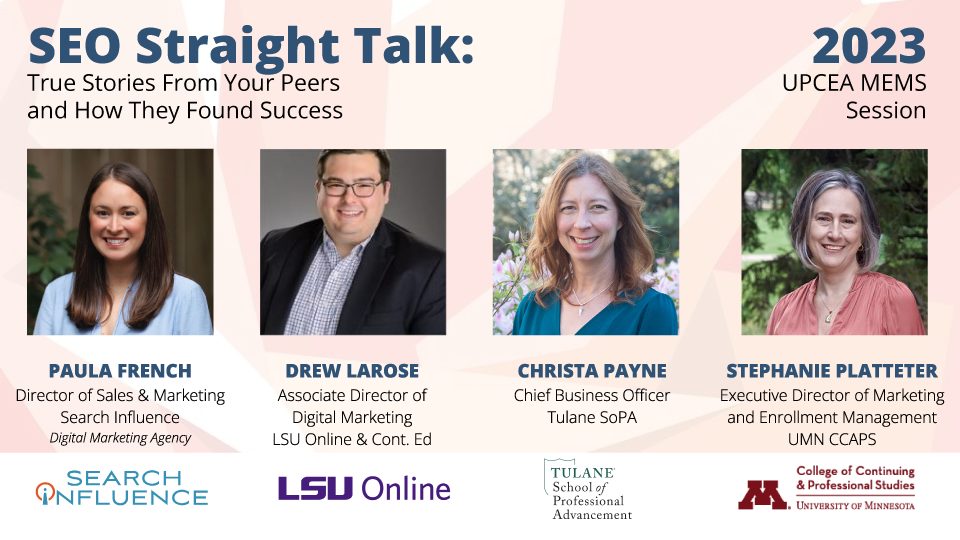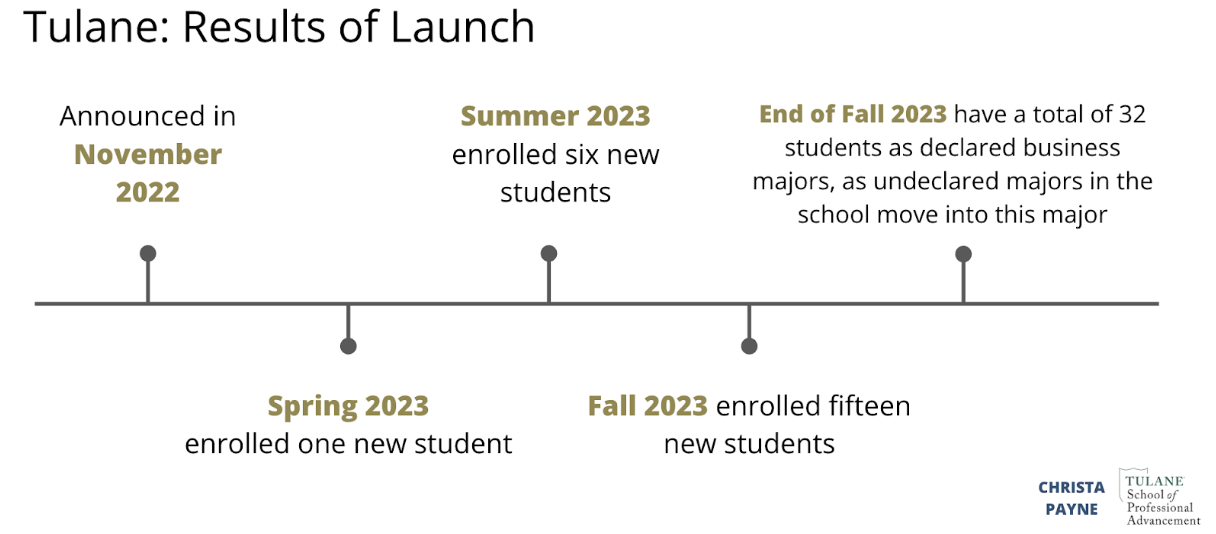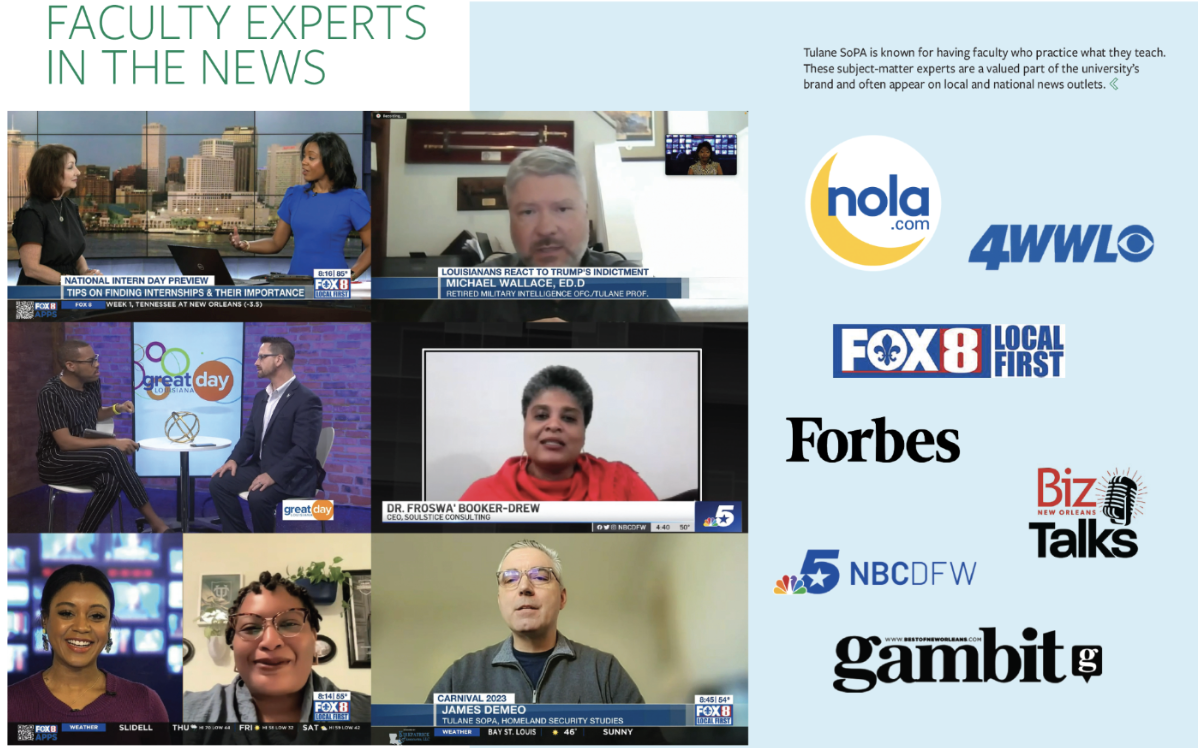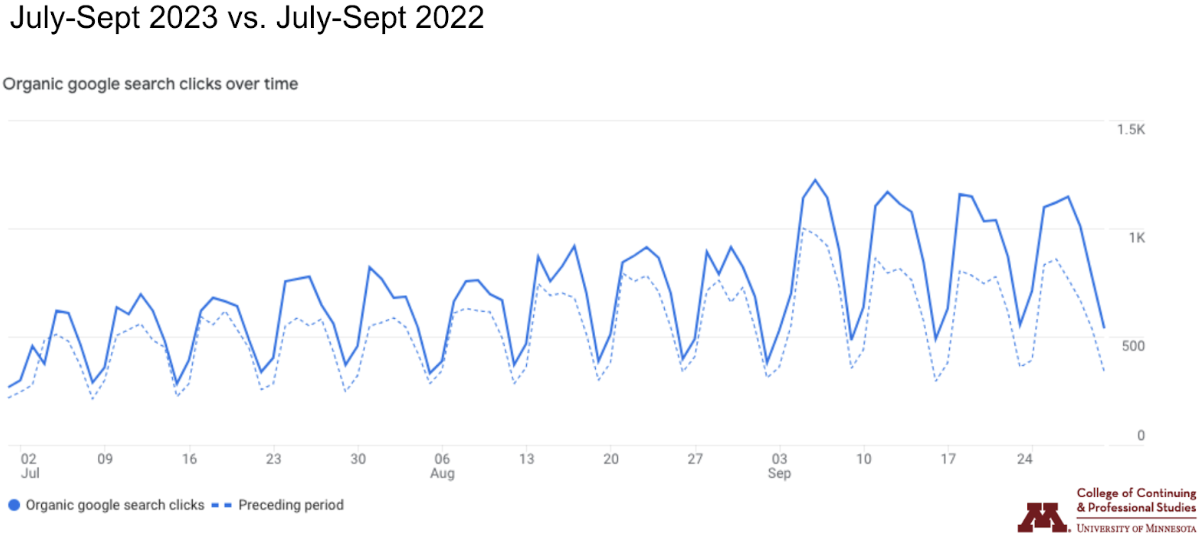UPCEA MEMS Conference Insights: SEO Strategy for Higher Education
November 29th, 2023 by

Key Insights:
- Research indicates that most people’s first interaction with a brand occurs through a search. This makes it critical to optimize your university’s online presence for SEO.
- Despite 84% of marketing departments considering SEO as a core part of their strategy, 51% of institutions surveyed still lacked an established SEO strategy. This gap in readiness can result in missed opportunities to attract prospective students and increase enrollment numbers.
- Building a successful SEO strategy for higher education starts with understanding search intent, conducting keyword research, and creating high-quality content that addresses these keywords. It’s also important to build authoritative links both internally and externally.
- Beyond content, universities must focus on website architecture, user-centric design, site speed optimization, and mobile responsiveness to improve discoverability and enhance the user experience.
For the second year in a row, Search Influence presented at UPCEA’s MEMS (Marketing, Enrollment Management, and Student Success) conference.
The UPCEA MEMS conference serves as a watering hole for higher education marketers, specifically those within professional, continuing, and online education.
At Search Influence, we help higher ed institutions ride the ever-changing waves of SEO strategies. We’ve spent years working on higher education SEO strategies that support universities nationwide in increasing organic traffic and attracting prospective students.
This dedication to building high-level SEO strategies for educational institutions led us to partner with UPCEA to connect with like-minded individuals.
Search Influence and UPCEA collaborated on a three-part research study to look at institutional and marketing leaders’ perspectives on SEO and evaluate the readiness of PCO (professional, continuing, and online education) units.
Our findings shaped our 2023 MEMS presentation. Armed with the understanding that universities need guidance in their higher education SEO strategies, we wanted to show real examples, from multiple schools, of what they have done to improve their visibility in search engines. It was important for us to show not just what the tactics are, but how they drove results. We partnered with 3 great institutions who we knew were effectively executing SEO to share how they have found success.
Keep reading to learn about our in-depth higher education SEO research and real-world SEO strategies you can implement on your university’s website.
Search Influence / UPCEA SEO Research Study: Key Findings
Our collaborative SEO for higher education research study with UPCEA began with a readiness audit of 100 UPCEA member institutions. This audit led to some surprising findings.
When those surveyed were asked, “How would you rate the SEO capabilities of your PCO unit on a scale of 1 to 5, where a 1 is not very capable and a 5 is extremely capable?,” 3.5 was the average capability rating. 41% of those surveyed rated their SEO capabilities as average or below.
An even more surprising finding is that 84% of marketing departments see SEO as a core part of their marketing strategy, but 51% do not have an established SEO strategy.
This missed opportunity leads to fewer clicks from prospective students and lower enrollment numbers for your higher education institution.
So, how can you improve your higher ed website’s SEO?
What are the first steps you should take to create an established SEO strategy for your higher-ed website?
Search Engine Optimization 101
You must utilize these strategies to keep search engines happy: keywords, content, and links. Think of these three things as your university website’s building blocks.
Keywords – what are people searching for when looking for your offerings?
Content – how well does your website provide information that speaks to those keywords?
Links – how well do other websites reinforce that you are an authority on those keywords?
Let’s talk through how that might look when you actually do this foundation work:
Every SEO for higher education strategy must start with determining a prospective student’s keywords (in other words, what terms do they search?).
For example, say you do some digging in Google Search Console and see your website receives a lot of website traffic for the phrase “online master’s programs.” Recognizing your audience is searching “online master’s programs” is your first win.
Now that you know your prospective students are scanning through search engines for “online master’s programs,” it’s time to do some keyword research to dial in your strategy.
You choose to use one of the many SEO tools (even a free tool will work) on the market to take an in-depth look at the search volume of “online master’s programs.”
Search volume looks good, but your SEO tools inform you this keyword will likely take much work to rank for. Not to worry, “flexible online master’s programs” has a similar search volume but will be much easier to rank higher for.
After thorough keyword research, it’s time to write high-quality content that uses your focus keyword, “flexible online master’s programs.”
You decide the best action is to write a 1,400-word blog titled “The Benefits of Flexible Online Master’s Programs for Working Adults.”
While you’re writing, you link to the pages you want to be associated with this idea, which are the degree pages that offer flexible online master’s programs. You also include links from highly authoritative external sites — you’re really getting the hang of things!
At the end of this process, you have an informative blog that answers your students’ search intent.
Now to earn authority, you leverage online profiles, media and PR mentions, and partners to build links back to this blog post as well as related program / degree pages.
Lather, rinse, and repeat this process continually. Over time, you’ll see your site’s search traffic rise.
After you’ve mastered SEO 101, it’s time to move on to the next course.
Search Engine Optimization 201
You’ve established relevance with your high-quality content.
You’ve taken the steps to earn authority with link building.
Now, it’s time to improve your discoverability by focusing on your higher-ed website’s architecture.
To earn rankings on a search engine, higher education websites must address three things: relevance, authority, and discoverability.
Fixing the foundation of your virtual storefront
Think of your website as a virtual storefront that welcomes and engages visitors. Sometimes, you need to fix things inside the walls or under ground to create a welcoming place for visitors, or perhaps improve signage to make it easier for visitors to find their way around. On a website, this is akin to the technical foundation and settings as well as the navigation and user experience.
Similar to how a brick-and-mortar retail operation would welcome a walk-in customer, the virtual storefront should prioritize the visitor’s experience and ensure that it is user-friendly, informative, and tailored to their needs.
One common pitfall many universities fall into is designing websites that prioritize their institution’s programs over the potential student’s needs. Additionally, while aesthetically pleasing, overly creative websites might lack a clear target audience, ultimately hindering their effectiveness.
To succeed in the competitive landscape of higher education, universities must shift their focus and design their websites around students, as well as break down technical barriers that may prohibit a site’s performance.
A few ways you can design your website around prospective students include:
- Creating a user-centric design
- Removing all broken links
- Creating clear navigation
- Ensuring your website is easily navigable when used on mobile phones (not just desktop)
- Prioritizing site speed optimization
Increase Lead-to-Application Conversion With Blogs — LSU Online
Our MEMS conference presentation partners at LSU Online increased their lead-to-application conversions with blogs.
The challenges they navigated included:
- Their programs’ official names are “distinguished” (not what people actually search for).
- They competed with on-campus version pages of the same degree.
- Many adult learners don’t know what degree they want to pursue.
LSU Online tested varying blog topic strategies to see results on search engine results pages, including:
- Start your career blogs
- Comparison content for two programs
- Faculty/director authored blogs
- Online student tips blogs
- Student story blogs
While these blog topics worked with varying success, this influx in targeted content led to an app increase of 17% in just one year. Moral of the story — high-quality content works.


Leveraging SEO audit tools for direction and monitoring
Like any other journey, you need a map to travel to the top of search engine rankings.
LSU Online found success using site audit tools to guide their rise in organic search traffic. Their SEO audit revealed broken links, broken pages, and program pages missing basic meta information (title tag, meta description, etc.)
These tools allowed LSU Online to bring their site audit score from 72% all the way up to 90%+.
Keywords + Content When Launching New Degrees — Tulane SoPA
In November of 2022, Tulane SoPA launched two new online bachelor degrees: An Online BS in Organizational Behavior & Management Studies and an Online BA in Human Resources.
SoPA went all in on SEO, primarily content creation and smart optimization, for these two programs as the primary means of promotion, as there was no specific paid advertising budget.
In one year, Tulane SoPA published 12 blogs that had high SEO value, including: “5 Reasons Every Business Needs An Organizational Management Professional,” “4 Key Legal Considerations for Starting a Small Business.”
As a result of these higher education strategies, Tulane SoPA had 32 students declared as business majors in just over a year.


Profiles and public relations to build links
Search Influence also assisted Tulane SoPA in finding sites with premium (paid) placement for external link building that had value – meaning, they were both authoritative and relevant.
We went through over 20 sites to help Tulane SoPA find the ones that might be worth it. In the end, Niche and Peterson’s had a fair price, high page and domain authority, and a relatively high percentage of followed links.
These backlinks helped to build Tulane SoPA’s authority.


Tulane SoPA also used public relations and earned media to enhance online visibility.
Tulane SoPA faculty completed over 100 earned media appearances in a year. Each appearance is shared on the Tulane SoPA news site, optimized for SEO value, as well as on social media.
The above content strategy helped Tulane SoPA rise in search rankings, thus increasing their visibility to potential students.
Drive New Website Users With Blogs — CCAPS at the University of Minnesota
CCAPS (College of Continuing & Professional Studies) at the University of Minnesota used blogs to drive web traffic.
Their content strategy goals:
- Generate brand awareness
- Increase web traffic and, ultimately, inquiries
- Earn backlinks from other sites and pass link authority to program pages through internal links
- Gain featured snippets
To do this, CCAPS did the following:
- Partnered with a digital marketing agency
- Posted 2–3 blogs per month
- Completed keyword research and targeting
- Combined content with schema markup, internal links, and backlinks to improve authority
- Amplification


Since July 2022, CCAPS published over 40 blogs, generating over 50,000 users by September 2023.
Core web vitals for SEO health
To climb search engines like Google Search, you must dive deeper into core web vitals for SEO health.
CCAPS used LCP (Largest Contentful Paint) to measure website load speed, TBT (Total Blocking Time) to measure their website’s interactivity, and CLS (Cumulative Layout Shift) to measure their website’s stability.
All of these web vitals allowed CCAPS to gauge their SEO health and adjust their strategies to rank higher on search results.
Learn More About SEO for Your Higher Education Strategy With Search Influence
Search Influence has helped organizations boost their search engine results and organic traffic for over 15 years.
From our years of driving results for Tulane SoPA to helping our partners at Palo Alto University exceed their expectations, we understand the factors that can help you rank on Google search and beyond.
Are you ready to identify keywords and Google trends on your own? Download our SEO Workbook for Higher Education Websites for SEO tips you can implement yourself.
Need a little more hands-on help to understand Google Analytics and local SEO? Contact the higher education marketing moguls at Search Influence to learn more about successful strategies.



